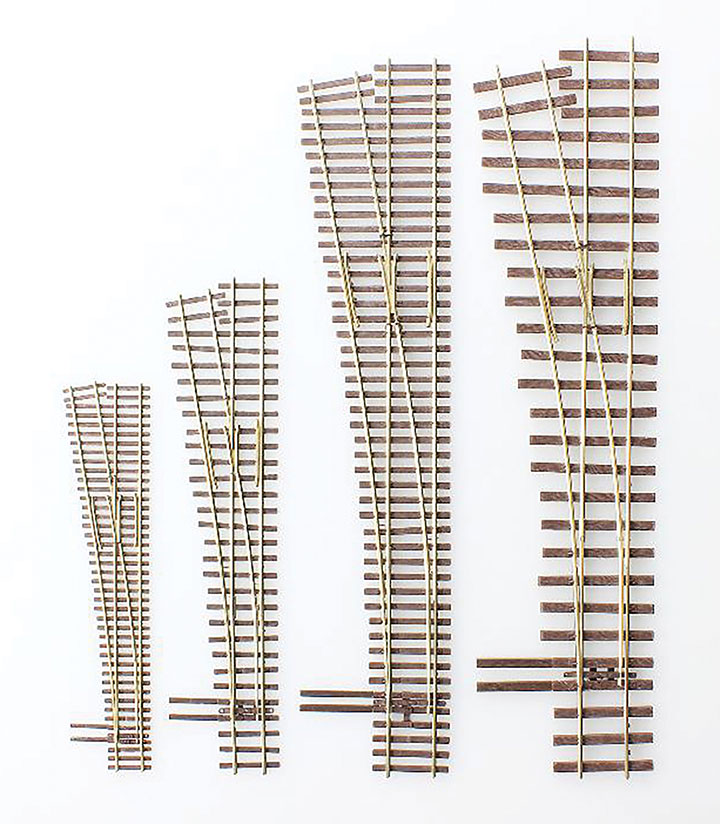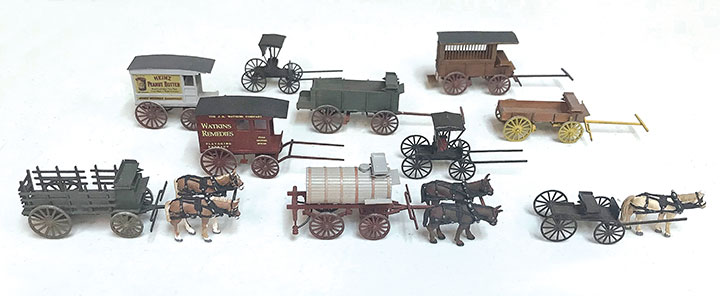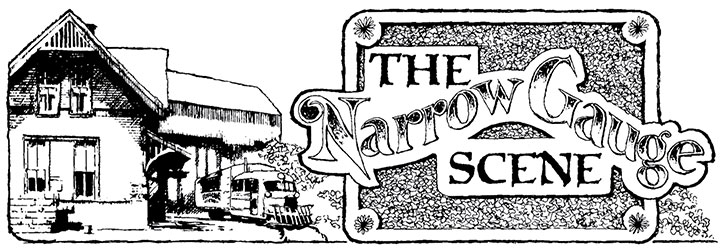Over the past few years, I have devoted an occasional column to the pioneer and prominent manufacturers in narrow gauge. After all, we enjoy a rich heritage of narrow gauge products developed over the years and the folks behind those products deserve recognition. In this column and at least one more, I hope to continue that practice. This column celebrates a truly generational family in the industry who has made, and continues to make significant contributions to our enjoyment of the hobby.
Our story begins with the late Bob Rands, a fixture at past National Narrow Gauge Conventions (NNGC) and founder of Micro Engineering (ME), the leading supplier of track and bridges/viaducts for both standard and narrow gauge lines. Bob was well known at NNGC, and train shows as well as for supporting the National Model Railroad Association with appearances at the National Train Show, held in conjunction with the NMRA Convention each year.
I never knew much about Bob except that he was indefatigably friendly and always upbeat. Late in life, Bob published an autobiography which he started at age 94. I am privileged to have a copy of this limited self-published work and learn more about the Rands family. Bob’s great grandfather went to California during the Gold Rush, panning for gold in the Sierra foothills south of Sacramento. His grandfather homesteaded near Grand Junction, Colorado, where his son, Bob’s father, Robert D. Rands Sr., helped on the farm. Fortunately, an aunt in Nebraska offered to help educate Bob’s father who eventually attended the University of Nebraska and obtained a PhD. in plant pathology from the University of Wisconsin.
Bob’s mother, Minnie, was an early feminist and suffragette. After marriage and working for a few years, the couple and their new daughter were sent to Java where Bob’s father helped with rubber tree disease prevention. This is where Bob was born. After four years in Java, the family returned to the U.S. via a grand tour of the world including India, Egypt and Europe. In India, they rode the Darjeeling Railroad, the twisty narrow gauge that still exists. They ended up near Washington DC where Robert Sr. worked for the Department of Agriculture. Bob attended the University of Maryland where he met and married Betty, later receiving a Doctor of Chemistry degree from the University of Illinois. Over time, Bob‘s family grew to six kids, and they relocated to Missouri. Bob worked in the chemical industry until he retired in 1978.
Bob got into model railroading after World War II and over time, discovered narrow gauge during trips to Colorado. A stickler for scale, it bothered him that in the early 1960s, the only rail sizes available were Codes 100, 70 or 40. None of those were correct for HOn3 D&RGW narrow gauge rail. So, in 1964, Bob created Railcraft to make and sell Code 55 rail for himself and any other narrow gaugers out there who might be interested. He met Ken Hathaway, who made flextrack for Kemtron and wanted to create tooling for Railcraft. Over time, Ken created some 13 tools sold by Railcraft, although maintaining his location in San Diego, California. Bob Rands also embraced the idea of creating flextrack of various scales and rail sizes, starting in the late 1970s coinciding with his work retirement. Two of Bob’s sons, Ron and Rich, bundled the rail with string and packaged products such as scale spikes or the track tools mentioned above.
Throughout the 1970s, Railcraft was busy making and selling a variety of track products. Ron and Rich were finishing their schooling, but still helped with the company. Bob was a half-partner with sons Ron and Rich in the company. In 1981, Rich created drawings of a D&RGW high side gondola with Ken Hathaway doing the tooling. Rich called his company Light Iron Models, later renamed Clear Creek Models. Originally, the gons were cast of resin in rubber molds but quality became a problem. The process could not ensure uniformity so the side lengths could vary. I remember building some of these early epoxy resin kits and they were a handful. They were also brittle, so it was difficult to drill holes or cut them. They could literally shatter. Noted traction modeler Bill Clauser, who later offered his own line of ¼-inch fine scale models, assisted Rich with the gon project and a new depot based upon the C&S depot in Silver Plume. Again, I recall resin epoxy versions of this depot and may have an original kit sitting around somewhere. Eventually, according to Rich, the Clear Creek models were produced with Evergreen styrene components and expanded to include Colorado Central and South Park cars, including box cars and gondolas. Clear Creek also offered modified Grandt Line Gilpin ore cars regauged for HOn3, not the HOn30 gauge, closer to their prototype 2-foot gauge, as made by Grandt Line.

1984 was a seminal year for the family operations. Micro Engineering was created, and a new manufacturing plant was built in Fenton, Missouri. Earlier, the company operated out of rented commercial space. By this year, Ken Hathaway had retired from his business efforts and ME acquired his tooling and injection machines. Sons Ron and Rich drove the machinery and tooling from San Diego to Missouri with a stop in Chama, New Mexico. Why Chama? Because ME had also acquired Durango Press from Jim Finnell who was then located in Chama. This included the Wheel Works line of white metal vehicles. ME thus diversified into injection molded plastic products beyond track work and white metal cast products. By the end of 1984, ME consisted of Bob, sons Ron and Rich plus one employee. The line expanded to include styrene false front buildings in HO and N scale. The Wheel Works line in HO and N was added. The O scale Wheel Works products were eventually sold to Keith Wiseman and the S products to Bill Peters of P-B-L.
There were other changes during the 1980s. Bob was now a half-partner with Ron in Railcraft and with Rich in ME. Rich did the tool and die work with Ron doing the Administrative and Product Development side. In 1987, there was a merger of Railcraft and ME with Bob, Ron and Rich as one-third owners. Tooling was improved over the years, moving from aluminum or brass into the much more durable and accurate hard steel tooling. The sale of the Durango Press/Wheel Works pieces that did not fit the focus of the company enabled ME to concentrate on product expansion. The innovative and modular bridge kits were added and again, expanded over time. These bridge and viaduct kits were popular and revolutionized bridge building. By now, ME had mastered the plastic injection process and the bridges plus component parts brought a new degree in flexibility and realism for bridge builders.
In 1998, Rich left the company to work for an outside company doing tool and die work. He also helped in promoting ME product sales to other companies. In 2002, On3 flextrack was developed. Again, this was another needed and essential product as were the bridges. On30 was added as well. When Bob Brown and I requested a sample of each type of flextrack from ME for the NMRA Magic of Scale Model Railroading exhibit at the California State Railroad Museum in Sacramento, we were staggered by the large box we received full of track in different scales and configurations. From G to N, track in different sizes and configurations are offered in a bewildering variety. From concrete ties to branch-line track, just about anything is available. The ME line of turnouts is also essential, especially with the recent demise of Shinohara track products. Over the past few years, an innovative line of space-saving HO yard ladder tracks has been added to the ME line. Though Ron ruefully mentioned the challenges posed by manufacture of these products, the ladder tracks for yards enables modelers to create yards in a smaller space than was previously available. A check of the ME website discloses a wide range of products essential to layout construction. Ron continues to operate ME with Kim Driskall and Donna Laver (Ron’s daughter) as part of the company. Recently, Ron decided to retire, and the company is being offered for sale.

In 2013, Rich and St. Louis modeler, John Kalin, obtained Berkshire Valley (BV) from the original owner, Frank Czubryt, who retired due to age. John Kalin later dropped out leaving Rich and his wife, Donna, to run the business. In 2017, BV obtained Anvil Mountain Models, formerly owned by an architect who produced highly accurate models of Colorado structures as well as O scale wagons and animals. Those kits are slowly being reintroduced to the market with the newest, an O scale version of the Walsh/Duncan Bay window house near Silverton. The HO version is also available. Though he inherited some O wagons from Anvil Mountain, Rich has expanded the line adding HO as well. As you know from past reviews, BV now produces numerous wagons in O and HO among many other products, including some O scale detail parts in white metal which I believe were originally part of the Chooch line. Other products include freight cars and false front structures. Indeed, Rich has added new products on a regular basis.

During the early years of the 21st century, Bob Rands continued to work at ME every day. In 2010 he was involved in a serious automobile accident and hurt his back. When he felt up to it, he would come in occasionally to ME and never formally retired. His beloved wife passed away leaving a void. The last few months of Bob’s life were spent in a nursing home before his death in June of 2017 at age 98. The company he created and more importantly, the two sons he encouraged, continue to serve model railroaders. Both Micro Engineering and Berkshire Valley offer essential models and products for narrow gaugers and indeed anyone in the hobby. Long may they continue. My thanks to Ron and Richard Rands for the information and photos used with this column.
Well, that’s all for now; until next time—write, if the mood strikes.
